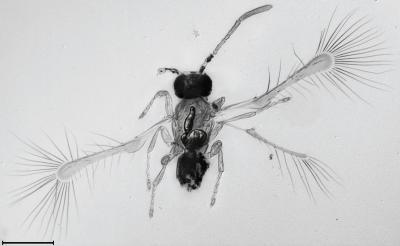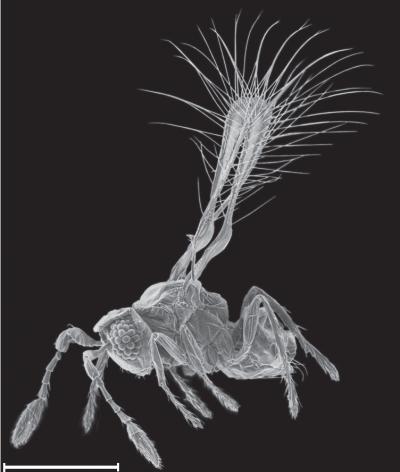Mymaridae, commonly known as fairyflies, are one of about 18 families of chalcid wasps. Fairyflies are everywhere except Antarctica and include the world's smallest known insect - Kikiki huna, the body length of which is only 0.13 millimeters.
Fairyflies are among the most common chalcid wasps but seldom noticed by humans because of their minute size. Their apparent invisibility and delicate wings with long fringes invoke imagery of mythical fairies and earned them their common name.
All but two known fairyfly species are parasitoids of eggs of other insects. These eggs are commonly laid in concealed locations, such as in plant tissues or in leaf litter or soil and are difficult to find, so for the most part the host insects of fairyflies are unknown. Specimens of a new species of fairyfly, Tinkerbella nana, from the provinces of Heredia and Alajuela, Costa Rica, were collected by sweeping in fairly young (no more than 20 years old) secondary forest mixed with a primary forest.

A female Tinkerbella nana. The Scale line = 100 μm. Credit: John T. Huber
All the specimens collected were below 250 μm in length. The reduced wing surface and relatively long setae of fairyflies and many other minute flying insects likely have an aerodynamic function, perhaps to reduce turbulence and hence drag on a wing flapping at several hundred beats per second.

Female Kikiki huna specimen. The scale line = 100 μm. Credit: John T. Huber
"If something is physically possible in living things, some individuals of at least one species, extinct or extant, will likely have achieved it. So the lower size limit, by whatever measure of size is chosen, was almost certainly already evolved—somewhere, sometime. If we have not already found them, we must surely be close to discovering the smallest insects and other arthropods", says the lead author, John Huber from Natural Resources Canada.


